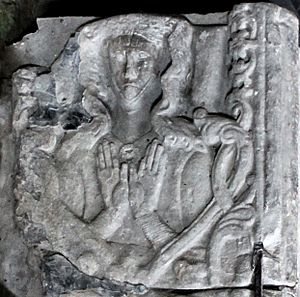Joan, Lady of Wales facts for kids
Quick facts for kids Joan |
|
|---|---|
| Lady of Wales | |

Detail of Joan's sarcophagus in St Mary's and St Nicholas's Church, Beaumaris
|
|
| Born | c. 1191 |
| Died | 2 February 1237 (aged 45–46) |
| Spouse | Llywelyn the Great |
| Issue | Dafydd ap Llywelyn Gwladus Ddu Elen ferch Llywelyn Susanna ferch Llywelyn Marared ferch Llywelyn Elen the Younger ferch Llywelyn |
| House | Plantagenet |
| Father | John of England |
| Mother | Clemence |
Joan, also known by her Welsh name Siwan, was a very important woman in Welsh history. She was the daughter of King John of England and became the wife of Llywelyn the Great. Llywelyn was the powerful ruler of most of Wales. People called Joan "Lady of Wales" or "Princess of Wales."
Contents
Early Life of Joan
Not much is known about Joan's early years. She was born around 1191 or 1192. Her mother's name was Clemence. Joan might have been born in France. In 1203, her father, King John, brought her to Kingdom of England. This was to prepare for her marriage to Prince Llywelyn ap Iorwerth.
Some stories say that Llywelyn the Great had a palace near a place called Trefriw. He built the church of Trefriw for Joan. This was so she would not have to walk a long way through the mountains to another church.
Marriage to Llywelyn
Joan became engaged to Llywelyn the Great in 1204. Their marriage likely happened in 1205. Together, Joan and Llywelyn had several children. Their most well-known children include:
- Gwladus Ddu (born 1206)
- Elen ferch Llywelyn (born 1207)
- Susanna, who was sent to England in 1228
- Dafydd ap Llywelyn (born around 1212)
Joan often helped to make peace between her husband, Llywelyn, and her father, King John. For example, when King John was fighting in North Wales, Llywelyn sent Joan to him. She helped Llywelyn try to make peace with the King.
In 1226, Joan received a special order from Pope Honorius III. This order said that she was a legitimate child. This meant her parents were not married to other people when she was born. However, this order did not give her any claim to the English throne.
Joan's Death and Burial
Joan passed away in 1237 at the royal home in Abergwyngregyn. This place is on the north coast of Gwynedd in Wales. Llywelyn was very sad when she died. He built a special Franciscan friary (a type of monastery) in her honor. It was built on the seashore at Llanfaes, right across from his home. This friary was finished in 1240, just before Llywelyn himself died.
Later, in 1537, the friary was destroyed by Henry VIII of England. Today, you can see a stone coffin in St Mary's and St Nicholas's parish church in Beaumaris. This coffin was once thought to be Joan's. Above the empty coffin, there is a slate panel. It tells the story of how the coffin was moved from the friary. It was even used as a horse watering trough for many years!
Some experts now believe that the carving on the coffin lid might not be Joan. The style of the carving seems to be from a later time than when Joan died. However, the crown on the carving shows it was a royal person.
Joan in Stories
Joan's life has inspired many stories and books:
- The Welsh play Siwan by Saunders Lewis is about Joan.
- Edith Pargeter's novel The Green Branch is set in Wales during Llywelyn's rule.
- Joan is the main character in Sharon Kay Penman's novel Here Be Dragons. In this book, her name is spelled "Joanna."
Images for kids


